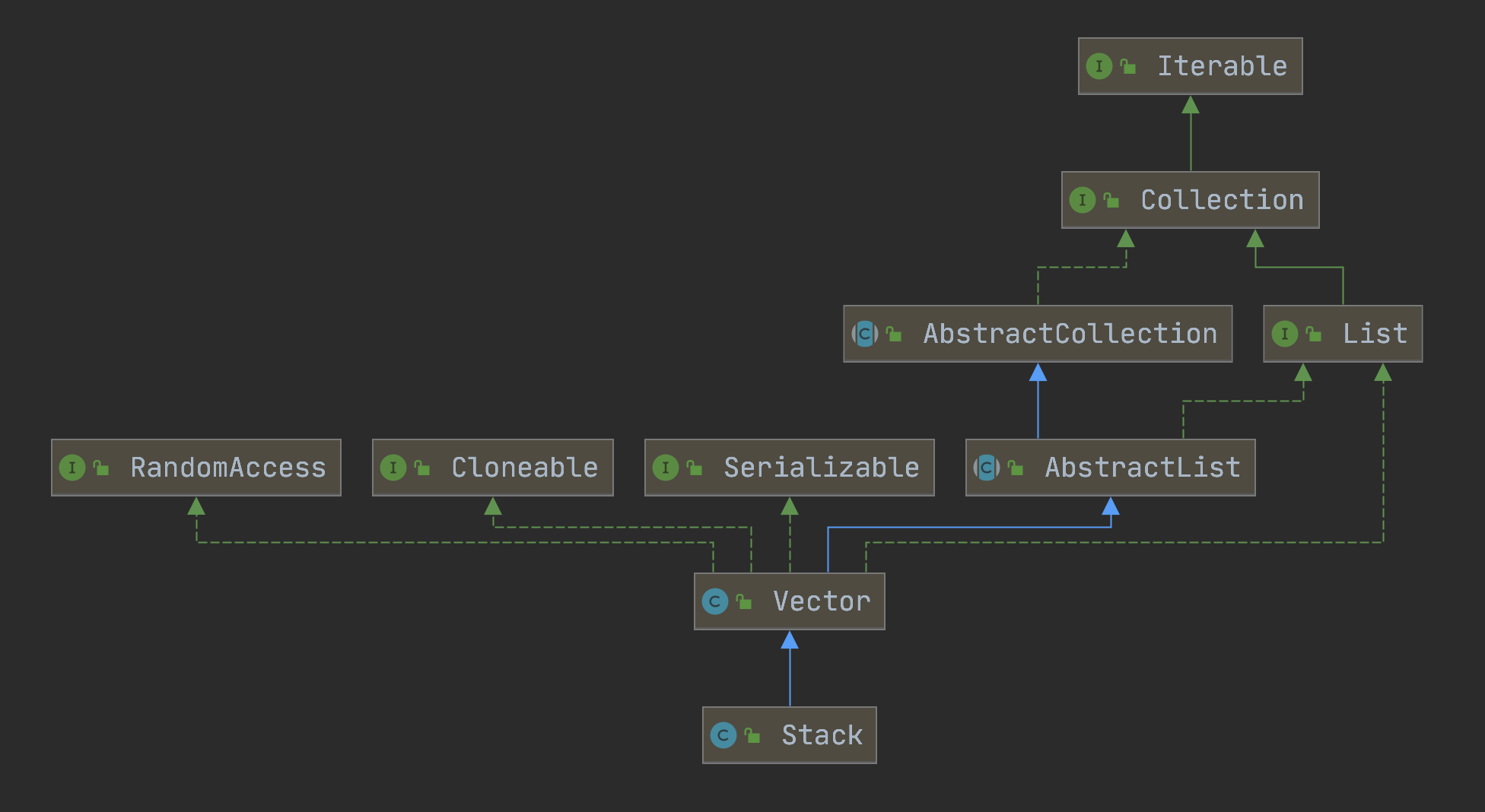栈和队列
栈
栈简介
- 栈是一种特殊的线性表,它只允许在固定的一端(栈顶top)进行插入和删除操作,栈中的元素遵循LIFO(Last In First Out)原则。
栈的实现
- 在JDK中,栈的实现类是
Stack,它的继承关系如下:
从上图可以看到,Stack继承自Vector,Vector与ArrayList类似,都是动态的顺序表,不同的是Vector是线程安全的。
Stack中的常用方法如下:
| 方法 | 功能 |
|---|---|
Stack() |
构造一个空栈 |
E push(E e) |
将e入栈,并返回e |
E pop() |
将栈顶元素出栈并返回 |
E peek() |
返回栈顶元素 |
int size() |
返回栈中有效元素个数 |
boolean empty() |
检查栈是否为空 |
常用方法时间复杂度:
访问:O(n)
插入删除:O(1)
- 栈的模拟实现
栈常用数组或链表来实现,用数组实现的叫顺序栈,链表实现的叫链栈。这里我采用数组实现一个简易的栈。1
2
3
4
5
6
7
8
9
10
11
12
13
14
15
16
17
18
19
20
21
22
23
24
25
26
27
28
29
30
31
32
33
34
35
36
37
38
39
40
41
42
43
44
45
46
47
48
49
50
51
52
53
54
55public class MyStack {
private int[] elementData;//存储数据的容器
private int elementCount;//栈中有效元素个数
private static final int DEFAULT_CAPACITY = 5;
//创建一个空栈
public MyStack() {
this.elementData = new int[DEFAULT_CAPACITY];
}
//入栈
public int push(int item) {
ensureCapacityHelper(elementCount);
elementData[elementCount++] = item;
return item;
}
//出栈
public synchronized int pop() {
if (size() == 0) {
throw new EmptyStackException();
}
return elementData[--elementCount];
}
//查看栈顶元素
public synchronized int peek() {
if (size() == 0) {
throw new EmptyStackException();
}
return elementData[elementCount - 1];
}
//判断栈是否为空
public boolean empty() {
return size() == 0;
}
//确认容器大小
private void ensureCapacityHelper(int elementCount) {
if (elementCount == elementData.length) {
elementData = this.grow();
}
}
//扩容
private int[] grow() {
return Arrays.copyOf(elementData, elementCount << 1);
}
//栈有效元素个数
public int size() {
return elementCount;
}
} - 验证
1
2
3
4
5
6
7
8
9
10
11
12
13
14
15
16
17
18public static void main(String[] args) {
MyStack stack = new MyStack();
stack.push(1);
stack.push(2);
stack.push(3);
stack.push(5);
stack.push(6);
stack.push(7);
stack.push(8);
stack.pop();
System.out.println(stack.peek());//7
System.out.println(stack.size());//7
while (!stack.empty()){
stack.pop();
}
System.out.println(stack.empty());//true
System.out.println(stack.pop());//java.util.EmptyStackException
}
栈相关的题目
LeetCode 20.有效的括号
给定一个只包括'(',')','{','}','[',']'的字符串s,判断字符串是否有效。
有效字符串需满足:
左括号必须用相同类型的右括号闭合。
左括号必须以正确的顺序闭合。
每个右括号都有一个对应的相同类型的左括号。
1 | public boolean isValid(String s) { |
剑指Offer 31.栈的压入、弹出操作
输入两个整数序列,第一个序列表示栈的压入顺序,请判断第二个序列
是否为该栈的弹出顺序。假设压入栈的所有数字均不相等。
1 | public boolean validateStackSequences(int[] pushed, int[] popped) { |
LeetCode 155.设计一个支持
push,pop,top操作,并能在常数时间内检索到最小元素的栈。
实现 MinStack 类:MinStack()初始化堆栈对象。void push(int val)将元素val推入堆栈。void pop()删除堆栈顶部的元素。int top()获取堆栈顶部的元素。int getMin()获取堆栈中的最小元素。
1 | class MinStack { |
队列
队列简介
- 队列只允许在后端(rear)入队,在前端(front)出队,队列中的元素遵循FIFO(First In First Out)原则。
队列的实现
队列的访问与插入删除操作的时间复杂度和栈类似,唯一的区别在于队列只允许新元素在其尾端(rear)进行添加。
Queue中的常用方法如下:方法 功能 boolean offer(E e)入队列 E poll()出队列 E peek()返回队头元素 int size()返回队列中有效元素个数 boolean isEmpty()检查队列是否为空 部分方法的区别:
offer()和add():若在队列满的情况下添加元素,add()抛出异常,offer()返回false()。poll()和remove():poll()在队列为空的情况下返回null。peek()和element():与remove()类似,peek()在队列为空的情况下返回null。队列的模拟实现
在JDK中,Queue是个接口,底层通过链表实现,我们可以采用Queue<E> queue = new LinkedList<>()来创建一个队列。1
2
3
4
5
6
7
8
9
10
11
12
13
14
15
16
17
18
19
20
21
22
23
24
25
26
27
28
29
30
31
32
33
34
35
36
37
38
39
40
41
42
43
44
45
46
47
48
49
50
51
52
53
54
55
56
57
58
59
60
61
62
63public class MyQueue {
private static class ListNode {
int val;
ListNode prev;
ListNode next;
public ListNode(int val) {
this.val = val;
}
}
public ListNode head;
public ListNode tail;
public int size;
//入队
public void offer(int val){
ListNode node = new ListNode(val);
if (head == null){
head = node;
}else {
tail.next = node;
node.prev = tail;
}
tail = node;
size++;
}
//出队
public Object poll() {
if (head == null) {
return null;
}
int val = head.val;
head = head.next;
if (head == null) {
tail = null;
} else {
head.prev.next = null;//处理前驱节点
head.prev = null;
}
size--;
return val;
}
//查看队头元素
public Object peek(){
if (head == null){
return null;
}
return head.val;
}
//查看队列长度
public int size(){
return size;
}
//判断队列是否为空
public boolean isEmpty(){
return size == 0;
}
}验证
1
2
3
4
5
6
7
8
9
10
11
12
13
14
15public static void main(String[] args) {
MyQueue queue = new MyQueue();
queue.offer(1);
queue.offer(2);
queue.offer(3);
queue.offer(4);
queue.offer(5);
System.out.println(queue.poll());//5
System.out.println(queue.size());//4
System.out.println(queue.peek());//4
while (!queue.isEmpty()){
queue.poll();
}
System.out.println(queue.poll());//null
}用链表实现的队列称为链式队列,链式队列的好处是除了用来存放指向下一个节点的
next指针外,它不会浪费其它空间,且它可以一直入队,直到系统资源耗尽,不存在越界问题。此外,还可以用数组来实现一个队列,称为顺序队列,顺序队列存在假溢出情况,即当我们进行入队、出队操作时,
front和rear都会向后移动,当rear移动到最后,我们就不能再向数组内添加元素,但实际上经过出队操作,front之前存在可用空间。为了解决假溢出,我们引入了循环队列。
循环队列
- 当我们把数组首尾相接的时候,无论入队还是出队,
front和rear总是在一个闭环内活动,这样就解决了数组假溢出和越界的问题,当front = rear时,队列为空。但由于不断地入队和出队操作,front和rear的总是在变化,我们该如何确定其相对的关系呢?答案就是取余操作。 - 模拟实现
1
2
3
4
5
6
7
8
9
10
11
12
13
14
15
16
17
18
19
20
21
22
23
24
25
26
27
28
29
30
31
32
33
34
35
36
37
38
39
40
41
42
43
44
45
46
47
48
49
50
51
52
53
54
55
56
57
58class MyCircularQueue {
private int[] element;
private int front;
private int rear;
//初始化队列
public MyCircularQueue(int k) {
//用冗余空间处理,k + 1
element = new int[k + 1];
}
//入队
public boolean enQueue(int value) {
if (isFull()) {
return false;
}
element[rear] = value;
rear = (rear + 1) % element.length;
return true;
}
//出队
public boolean deQueue() {
if (isEmpty()) {
return false;
}
front = (front + 1) % element.length;
return true;
}
//返回队头元素
public int Front() {
if (isEmpty()) {
throw new RuntimeException("队列为空");
}
return element[front];
}
//返回队尾元素
public int Rear() {
if (isEmpty()) {
throw new RuntimeException("队列为空");
}
//当rear = 0,此时若直接取rear - 1将数组越界
int index = (rear - 1 + element.length) % element.length;
return element[index];
}
//判断是否队空
public boolean isEmpty() {
return front == rear;
}
//判断是否队满
public boolean isFull() {//考虑出队front会变,不能(rear + 1) % element.length == 0
return (rear + 1) % element.length == front;
}
}同时它也是LeetCode 622.设计循环队列的解法。
队列的拓展
- 阻塞队列(
BlockingQueue):当队列为空时,出队操作阻塞;当队列为满时,入队操作阻塞。主要用于多线程。 - 双端队列(
Deque):具有栈和队列的性质,比起栈或队列,它更加灵活,插入和删除操作可在两端进行。
经典题目
以下题目均来自LeetCode。
用两个栈实现队列
队列的声明如下,请实现它的两个函数
appendTail和deleteHead,分别完成在队列尾部插入整数和在队列头部删除整数的功能。(若队列中没有元素,deleteHead操作返回 -1 )
1 | class CQueue { |
两个栈实现队列
实现 MyStack 类:
void push(int x)将元素 x 压入栈顶。int pop()移除并返回栈顶元素。int top()返回栈顶元素。boolean empty()如果栈是空的,返回 true ;否则,返回 false 。
1 | class MyStack { |

